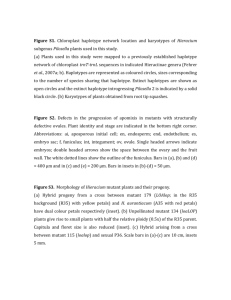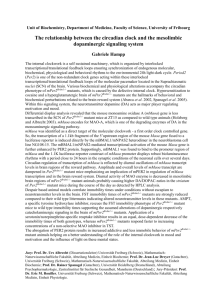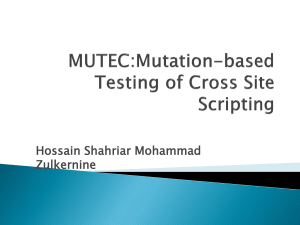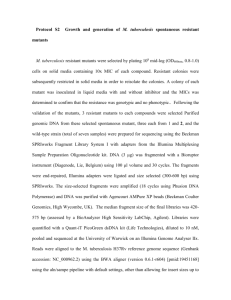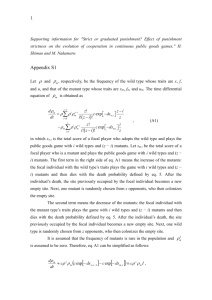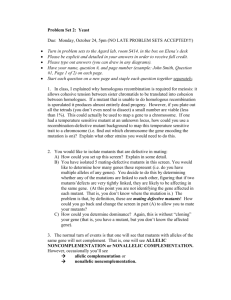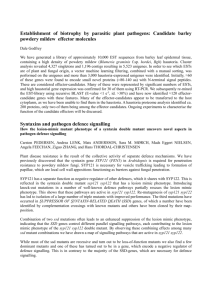Recessive Mutants in a Wild Drosophila melanogaster Population
advertisement
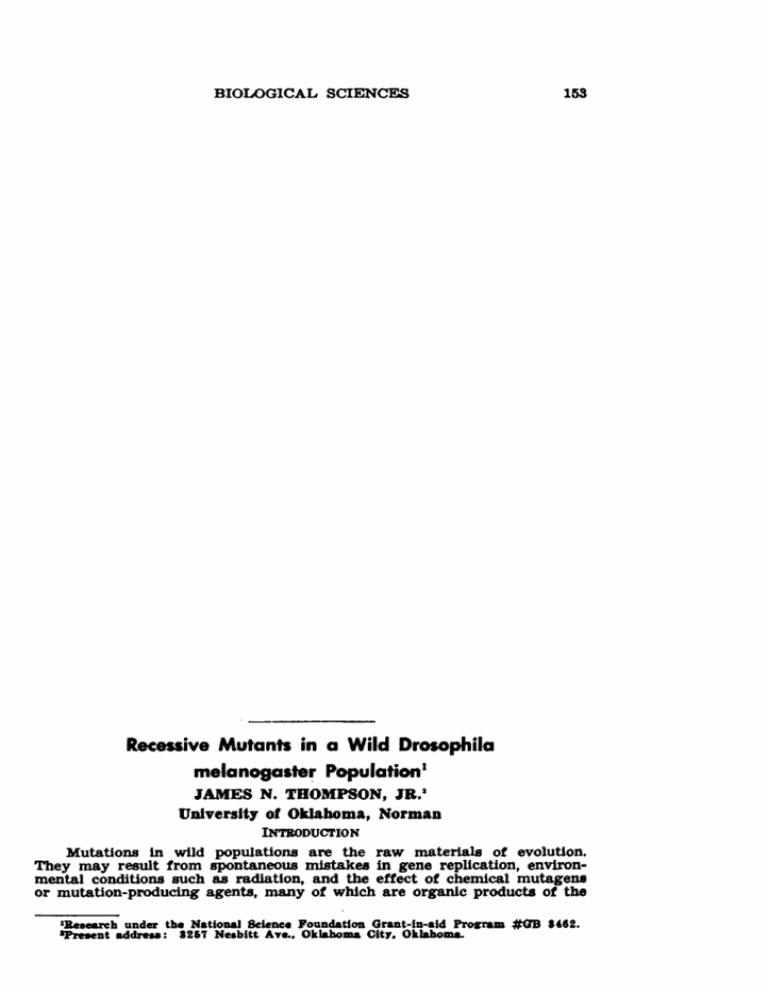
BIOLOGICAL SCIENCES 153 Recessive Mutants in a Wild Drosophila melanogaste~ Population l JAMES N. THOMPSON, JR. J University of Oklahoma, Norman INTRODUCTION Mutations in wild populations are the raw materials ot evolution. They may result trom spontaneous mistakes in gene replication, environmental conditions such as radiation, and the effect ot chemical mutagens or mutation-producing agents, many ot which are organic products ot the lBeaeareh under the National Science Foundatin Grant-in-aid Proeraaa #<lB 1412. 'Preaent adclreu: 1251 Nesbitt An., Oklahoma City. Oklahoma. PROC. OF THE OKLA. ACAD. OF SCI. FOR 1966 1M o~'a own body. )loa Dr~OfIIlUG in nature are phenotypically wild- type. The pnotype, however, often includes recessive genes masked by the wUd-type allele. Dominant and sex-linked mutations are -recovered leu frequenUy becaU8e of Increued pressures ot selection against them, 1e., there fa Uttle butter between them and the environment. Recessive mutants, even it detrimental in a homozygoua condition, are retained for a long time in the gene pool of the species, since the probability ot obtain1nI' a bomozygoua receuive individual is nonnally low and selection, therefore, alow. In addition, heterozygosity Itself is frequently advantageous to the Indlvtduala, produclng an eftect called "hybrid vigor." are In the laboratory, aeriea ot croues, such as Will be described later, uaed to analyze the chromosomes and determine the frequency with which a certain receutve mutant is carried. Such an analysis may eventually be UNlul in Inveat1gating the rate of mutation in the population. several population genetics studies of this type have been done with DroaoplltlG species. Tachetwerikoft, tor example, collected 239 wild DroaophUG and, in analyzing them, found 32 different recessive mutants carried in a heterozygous condition (Gardner, 1960). Dubinin found that the number of mutant genes carried varies with the season (Gardner, 1980). In a Itudy of 130,000 wild D. melanogaBter from several locations in southern RU88la, Dublnin and his co-workers found more than 2,800 "aberrant" indivtduall, many of which carried mutant abnormalities (Dobzhansky, 1941). Dobzhansky (1937), stUdying D. P8eudoobscura, found that approximately 25% of all tested autosomes carried a recessive lethal or semllethal mutant, while 4-14% of the chromosomes carried a atermty mutant. The present study represents an attempt to analyze the mutants causing morphological changes carried in the wild populations ot D. meJatlOgtJater in and near Marshall County, Oklahoma. Special attention WU given to mutants affecting the wings, bristles, and color ot body and eye. METHoDS WUd D. mela"ogaater were collected in adapted funnel traps (ThompIOn, in preaa). D1'~opAUGI attracted by the banana balt, enter a small tunnel opening into a glus jar. Because the opening is small, finding it aga1D .. difficult, and the flies are trapped. Collections were made in the eveninp at four major areas, concentrated collections being made on the carnpua ot the Oklahoma University Biological Station, WUlls, Oklahoma. Other collection utes were near the Willis Bridge, Texas, five mUes southwest of the mUon; Madlll, Oklahoma, approximately 20 mUes north; and Nocona, Tuu, approximately 60 mlles southwest. Collection sites on the atation grounc:la were centered around the kitchen area. Grocery stores at the other locations served as trapping 81tes. Collections were made from 22 June to 18 July 1966. The present aeries of CI'088e8 was divided into two sections. One eecUon utlllzed wUd females, and the other utUlzed wild males and virgin females gathered as larvae at collection 81tes. The t1rat section was made up of 77 teIted females, whlle the HCOnd section comprised 16 male-female CI'OIIU. Wild temal. were placed singly In culture vials as they were collected. The food UHd In their vials was a Cream-of·Wheat and molasses medium (Demerec and Kaufmann, 19M). Females were allowed to lay 8IP and their off8pring to develop. Ten virgin females were collected from each vial aa they eclosed and were placed singly In 10 fresh culture vIalL To each vial a liDgIe brother was added. The offspring of each of theee Cl'08HI were collected, cla8IWed, and recorded. By following BIOLOGICAL SCIENCES this method, a recessive mutant carried by the original female or the wild inseminating male would have a high probability of becoming homozygous In the second generation and being identified in approximately one-fourth of the offspring of one-fourth of the second generation. The second series of crosses, utllizlng wild males, was carried on In a similar manner. The main ditference was that instead of using already inseminated females, pair matings were made between wild males from the traps and females collected as larvae and gathered &8 they eclosed in prepared culture vials. Offspring of these crosses were mated in 10 pairs, as described above, and the second generation was collected and classified. Bridges and Brehme (1944) was used, insofar &8 possible, as a reference of mutant types. However, further tests must be run to definitely identify the mutants recovered in these crosses. Thus, mutants in the results section are listed by a short morpholOiPC&1 description, instead of by name. All mutants reported are only "presumptive mutants" subject to confirmation by later tests. RESULTS In section 1, Involving trapped wild females, 77 females were tested. Of these, 67 tests were successfully completed; the others were terminated by mold. For each female 10 vIals were made to recover any recessive mutants present on the chromosomes. From this total of 670 vials, 26,597 second generation offspring were collected and examined. The results of the examination are presented in Table I. Presumptive mutants are listed under four categories: bristle mutants, color mutants, wing mutants, and miscellaneous. Wild-type (normal) flies accounted for 20,858 of the offspring, as was to be expected, for the vast majority of flies should carry at least one set of normal genes. Of the now homozygous mutant Individuals, the most prevalent phenotype was a variably expressed bristle mutant which shortened and thickened bristles at random, affecting all or part of the total number of bristles. This was present in 6lS (97%) ot the temales tested. In section 2, involving wild males, 16 tests, including an unsuccessful one, were attempted. From the 150 vials, 8708 second generation offspring were collected and classIfied. The results are summarized in Table n. Wild-type flies again accounted for the great majority, 2678 individuals. The same bristle mutant encountered in section 1 was again found in 14 ot the 15 sets and was identified in a total of 927 offspring. Three mutants were identified in the second section of crossea which were not present in section 1. These were brown eye color, rudimentary-like wings, and nicked wing tips. In the stocks which were made of the mutanta recovered in these tests, three additional mutants were later discovered. These were deltalike wings, erected wings, and wings bent at two places over the abdomen. Since these were not recovered &8 a definite number of individual8 from a known number of original vials, they can not be included in the tablea. Although collections were made at several dltferent locations, the results of such collections were not greatly different from the main collections on the biological statton grounda. All collections are thU8 reported together, with no notation as to location. DISCU88l0N AND Q)NCLUSION8 In the 98 attempted teats reported here, a total of 88 di8t1DgujahabJe mutants were recovered from 82 succeaful testa. All mentioned before, 11 sets were JdUed by mold growth. Mo8t lleta contained more than one mutant, and 80JDe carried u many u eight. Counting each dJfferent PROC. OF THE OKLA. ACAD. OF seL FOR 1966 1M TABLE L No. of sets involved No. of indlv. involved 11 20,353 65 2 1 4951 321 1 5 5 3 3 2 1 1 55 52 143 61 20 46 35 19 12 8 5 4 3 3 2 1 1 1 1 1 1 1 1 1 1 138 106 88 22 15 8 indet. 35 10 7 14 6 14 13 20 32 4 5 A. Wlld-type (nonna!) B. Bri8t1ea 1. Irregularly stubbled 2. "Stubble"-Uke 8. "Singed"-Uke C. Color 1. Orange eye 2. Brown-streaked thorax 8. Yellow body 4. Brown body 5. Light-red eye 6. Red-brown eye 1. "Plum"-llke eye D. Wings 1. 2. 3. 4. 5. 6. 1. 8. 9. 10. 11. 12. 13. 14. 15. 16. 11. 18. Bent wing base Fragments of extra veins present "Dlchaete"-like Notched VeIn V not touching the wing margin U-ahaped wing notch Wavy Small, almost opaque, wrinkled VeIn LII broken Folded Thickened veins Eave-like Held out with rough veins Vein LII forked "Miniature"-like Posterior cl"OSSvein half present Added crossvein Ballooned E. Miscellaneous 1. 2. 3. 4. F. SECTION 1 OCCUBBENCE OF MUTANTS: Mutant Abnonnal abdominal segmentation Sterility mutant Low viablUty factor Rough eye Others (unsuccessful) 9 2 1 1 _. _. 87 4 10 • These mutants are functions of the set. not of individuals. occurrence of a mutant separately, 249% of the tested females in section 1 carried a recesslve mutant. and 206% of the original parents in section 2 carried a mutant. It should be noted that this only includes morpholoatcal mutations. with the exception of two affecting fertility and viabilIty. It is al80 important to remember that the morphological mutants are concentrated in only three main areas. Although these are very repre8eIltaUve and important characters, other mutations could have occurred which. because of their nature, were not recognized. Two nonmorphological mutants were tentatively Identlfted. Thls is unusual, since the crosses were not intended to pick up thls type of mutation. Mutants affecting vlabUlty aDd ferWlty must normally be detected using a completely dlt- BIOLOGICAL SCIENCES TABlE n. OCCURRENCE OF MUTANTS: Mutant 1. SECTION 2 No. of sets involved No. of lndiv. involved 16 2678 14 927 1 1 21 12 4 3 12 20 A. Wild-type (normal) B. Bristles C. lrs7 Irregularly stubbled Color 1. Brown eye color • 2. Orange eye color D. Wings 1. Bent wing base Fragments ot extra veins present Vein LII broken 4. Ballooned 5. "Rudimentary"-Uke • 6. Nicked wing tips • 1. Vein V not touching wing margin 2. 3. 1 1 1 1 1 Irs 8 6 15 4 10 E. Miscellaneous 1. Abnormal abdominal segmentation 3 F. Others (unsuccessful) 1 * These mutants did not occur in Section 1. ferent system of matlngs. ThUS, the number of mutants reported here, though rather large, is almcst certainly only a small fraction of the actual existing mutants carried by the original parents and by the population at large. The significance of these data can best be evaluated by comparing them with data from earlier similar studies. The stUdy by Tschetwerikoff (Gardner, 1960), though carried on under different conditions, affords such a comparison. Tschetwerikoff collected 239 wild Drosophila and obtained 32 different recessive mutants. Thus far this series has tested 82 wild Dr080phila me!anogaBter and recovered what appears to be 33 different mutants plus three appearing later in the stocks. It should also be noted that Tschetwerikotf stud!ed all body parts while this series concentrated on Wing, color, and bristle mutants. Thus, it can be seen that the results of this latest series are strikingly dIfferent from the earlier ones. The number of ml'tants carried in the population now under study appears to be sltnllficantly greater. Possible reasons for such an increase are very important to investigate, especially It this same increase in gene pool mutants is occurring in other animals, including man, for an Increase in the mutants carried in a population increases the number ot mutant individuals that will occur. There are several possible explanations for the increase in recessive mutants. One concerns the area in which the tests were carried on. It has been shown (Muller. 1928) that high temperatures can increase the mutation rate under certain conditions. The present study was made in the temperate cllmate of Oklahoma, while that ot Tschetwertkoff was done in the much colder Ural Mountains. There is also the poS81bllity of different selection pressures under these varied environmental conditions. Radiation is yet another possibiUty; its mutation-inducing effects are well known. ·Radiation from fallout, however, bas been esttmated to be from 1/10 to 1/30 the level of natural background radiation, and CODH- 1&8 PROC. OF THE OKLA. ACAD. OF SCI. FOR 1966 quently will cmly account for a small percentage of the observed sponta.neo1w mutanbl (Glautone, 1962). Additional investigations will need to be planned to atabUah the caWle, if poastble. A certalD bri8t1e mutant wu obeerved in the offspring of 97% of the wild parenta. Although thl8 at first seems unusual, it can be fairly euUy explained. In a hypothetical. scheme, the production of normal br1It1. proceedJl lUI a chain of reactions each of which 18 catalyzed by a dlfterent enzyme: A->B->e->D->brlBtJe. Each enzyme 18 produced by a dtfterent gene or genes. Thus, a mutation at anyone of the several loci involved In bristle production would result in a mutant ortJlDal brl8t1e phenotype. In a population carrying several different brlstle-affecting mutationa, the frequency of their occurrence would likely be high enough 10 that a very large percentage of the population would carry one or more of them, especially If the heterozygous condition were beneficial U in hybrid vigor. Several mutations of thlB type could also explain the variability In the expreu10n of thiB mutant. The other mutants obtained in thl8 study ditter, In that they represent mutations at a single gene locu. Likewl8e, one further posaibillty is that the bristle mutant represenbl & B1ngle mutation which, due to hybrid vigor, is carried in a heterozygoua condition In & large number of Individuals. It 18 hoped that future studi. will cJartty th18 phenomenon. From the above dl8cusslon it can be seen that the number of mutants carried In a heterozygous condition is much greater than reported by earller Investlgators, indicating an increased rate of mutation and/or a reduction in selection pressure against the mutant alleles. Further study mult be made, however, to determine the cause of this phenomenon. ACXNOWLmGMENT8 I would like to thank the many people who showed their Interest in We project by their friendly suggestions, and the University of Oklahoma Biological Station for the use of equipment and laboratory space. I would upecla11y llke to thank Dr. Gerald Braver, University of Oklahoma, for his Invaluable advice and aasl8tance. LLTERATUD CITED Bridges, C. B. and K. S. Brehme. 19~4. TAB Mutelnta 01 DrQtJophUa melaMgaater. Carnegie Inst. Wash. Pub). 552, Wuh., D.C. Demerec, K. and B. P. Kaufmann. Inst. Wuh.. Wuh., D.C. p. 10. 1937. Dobshanaky, Th. Untv. Preas. N.Y. 1964. DroaopMlCl Gtdde. carnegie a.etfc.t elM tM Origtft 01 Bpeciea. Columbia Dobsbansky, Th. 1941. Qfmtb elM tM OrigMI 0/ lumbia Unlv. Preu, N.Y. p. M. Gardner, Eo J. N.Y. B~, 2nd Ed. C0- 1980. .Pritsdpla 0/ Qnettca. John WUey and Sons, Inc., OJaatone. S. (eeL) 1882. 2'Ae .llecA 01 N,",leGr W6GJJ0"8. U.S. Atomic EDergy Comm. p. 617. KuDer, B. J. 1928. DroIop~ ita The meuu.rement of gene mutation rate in high variabUity. and ita dependence upon temperature. GeDet1ca 13: 2'l9-I57. . Thompeon. J. N. Jr. (in press). IDexpenslve fruit fly trap adapted for cJaaroom... Turtox Newa.

